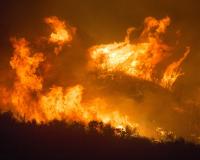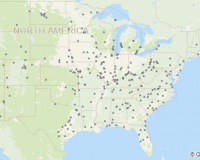
Vibrant Environment
Climate Change And Sustainability
All | Biodiversity | Climate Change and Sustainability | Environmental Justice | Governance and Rule of Law | Land Use and Natural Resources | Oceans and Coasts | Pollution Control

As climate change worsens, so does the risk of wildfires. This is especially so in the western United States, as seen all too well in California in recent weeks. Adding fuel to the fire are the increasing number of homes built near areas prone to wildfires, the wildland-urban interface (WUI), which increases the risk to people and their homes, makes wildfires harder to control, and prohibits fires from being allowed to burn naturally.

Japan has been no stranger to large environmental and natural disasters over the last decade: the country has experienced several typhoons with flooding, earthquakes, heat waves, as well as the infamous Fukushima Daiichi nuclear disaster in 2011. In September, Typhoon Faxai hit Tokyo and Chiba prefecture; its strong winds and rains halted train service, damaged buildings, and took down power lines. It left three dead and dozens injured. Only a few weeks later, Typhoon Hagibis tore through the Kanto and Tohoku regions. The typhoon was so strong that three days after reaching Japan, the National Weather Service in Anchorage, Alaska, reported remnants of the typhoon had reached the other side of the Pacific.

Although it may not be a trending cocktail party topic, coal ash compliance activities are certainly well-known in the legal and environmental risk management community. Billions of dollars are at stake for the owners and operators of coal power plants impacted by the 2015 Disposal of Coal Combustion Residuals (CCR) rule.

Some months back, I received a visit from two leaders in the climate science and sustainable energy arena: the former president of Climate Central, Paul Hanle, and David van Hoogstraten, who had just left his position as director of federal environmental regulatory affairs at BP America.

During the 19th century’s period of rapid population growth, America’s wetlands were largely considered to be an eyesore and an obstacle to development. These were bodies of water that needed to be drained in order to make way for agriculture, buildings, and major roadways. The successive Swamp Land Acts of 1849, 1850, and 1860 turned titles of federally owned swamp and “overflowed” land over to states, who in turn agreed to drain the land to make it fit for cultivation.

Greta Thunberg’s arrival in New York last month was highly publicized. So was her choice to travel via a “zero-emissions” yacht and her speech before the U.N. General Assembly. What many missed was that she also filed a complaint against five countries over their climate negligence during her visit. But before Greta, there was (is) Juliana (well, Kelsea). Kelsea Cascadia Rose Juliana is the leading plaintiff in Juliana v. United States, otherwise known as the Youth Climate Case. Supported by the nonprofit organization Our Children’s Trust, Juliana and 20 other youth plaintiffs sued the U.S. government in 2015 over its lack of action to combat climate change. Greta and Juliana’s cases are among a small but growing docket of climate-related litigation around the globe, cases that may become the Marbury v. Madison of climate case law.

A number of bills have been introduced in recent years to price greenhouse gas (GHG) emissions via a federal carbon tax. These proposals proceed from the implicit assumption that the federal government in general, and the U.S. Environmental Protection Agency (EPA) in particular, does not already have such authority. But this assumption, according to former EPA Assistant Administrator and General Counsel E. Donald Elliott, is incorrect.


The easiest way to reduce emissions is to avoid producing them in the first place. Because a carbon fee makes it more profitable to avoid carbon emissions, it encourages businesses and individuals to conserve energy, reduce emissions, and develop innovative technology.

It is estimated that over 800 million people will be at risk from the impacts of rising sea levels by 2050, concentrated among 570 coastal cities across the world. Some of these cities have already started to experience the impacts of sea-level rise and storm surges, which has catalyzed efforts by governments and individuals to begin preparing for more projected effects.

I have a confession: I can’t stand the “what’s your occupation” question—credit card applications, cocktail parties, whatever. I find it limiting and often irrelevant. Truth be told, I haven’t known how to answer the question for years. “Environmental, Health, and Safety Executive?” “Sustainability Leader?” “ESG Champion?” The reality is that my default answer has become “recovering environmental lawyer” but I worry that’s insensitive . . . !